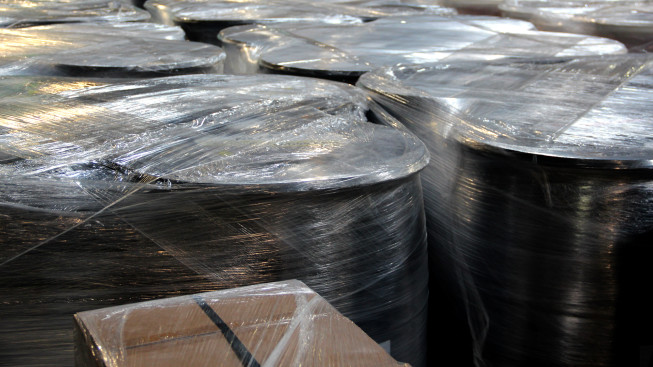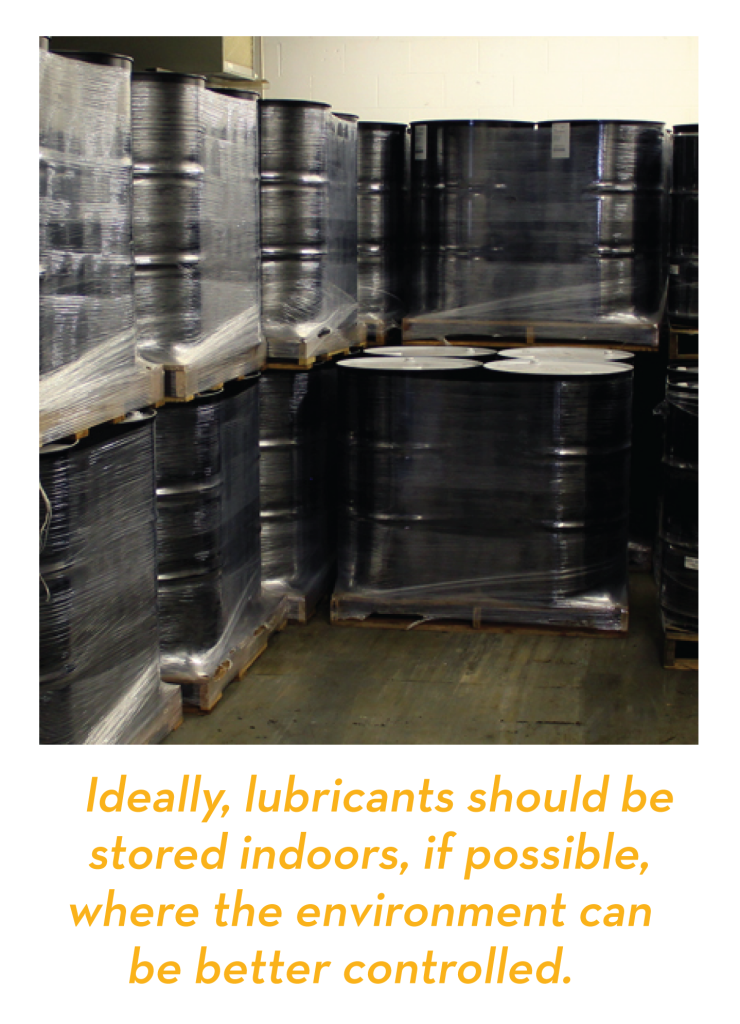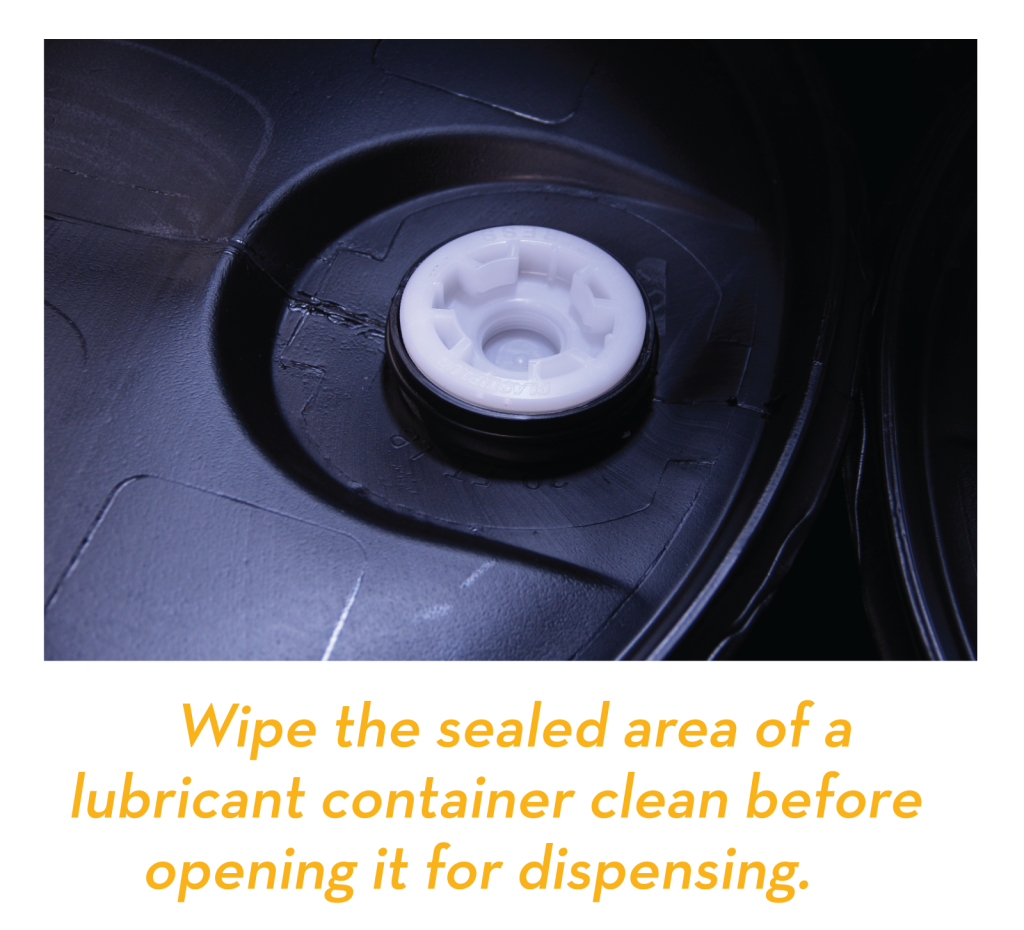

If you want to improve the performance and service life of your lubricants, take a look at your storage and handling procedures. Often treated as an afterthought, storage and handling can have a significant impact on the success of your lubrication program. Start by answering these important questions:
Are any lubricants you have in stock languishing on your shelves?
Most lubricants can be stored for a substantial period without consequence, but they won’t stay pristine forever. If a lubricant is stored too long, even in optimal conditions, it can lose performance capabilities and eventually become useless. This wastes oil and your money.
Rotating inventory on a first-in, first-out basis can help remedy this problem. Arrange storage shelves and racks to facilitate this rotation, ensuring that new purchases are placed in the back and older stock moves forward for use before its shelf life ends.
Purchasing lubricants in appropriate package sizes for your needs can help as well: Unopened, factory-sealed containers of lubricant can be stored longer than those that have been opened for partial dispensing.
Also consider your lubricant supplier’s order-processing and delivery time. A vendor with a fast turnaround time, such as Isel, may help you meet lubricant demands in a timely manner while also helping to keep your inventory fresher.
What is the environment like where your lubricants are stored?
Whether your lubricants are stored indoors or outside, environmental conditions can reduce their shelf life. The fluids are vulnerable to contamination by dust and dirt. Fluctuating temperatures cause a reaction known as thermal siphoning, in which air moves in and out of the container’s head space and the atmosphere — even in sealed containers with no oil going in or out. Moisture and airborne particles travel with the air, resulting in contamination and degradation of the oil. Extreme hot or cold temperatures can lead to chemical degradation as well.
 Ideally, lubricants should be stored indoors, if possible, where the environment can be better controlled. A clean, dry environment kept at a stable, moderate temperature is best. Do not, for example, store lubricants near sources of heat or steam.
Ideally, lubricants should be stored indoors, if possible, where the environment can be better controlled. A clean, dry environment kept at a stable, moderate temperature is best. Do not, for example, store lubricants near sources of heat or steam.
If outdoor storage cannot be avoided, lubricants should be sheltered as much as possible from environmental conditions that may degrade them. For example, a roof or tarpaulin can help shelter lubricants from precipitation as well as from the heat generated by direct sunlight. In addition, placing containers on blocks or racks can help protect them from ground moisture.
More general storage tips for indoor or outdoor storage:
- Store lubricants in a single indoor location (or just one indoor and one outdoor location, if some products must be kept outdoors) at your facility for easier inventory management.
- Ensure easy access to all products:
- Aisles should be wide enough for forklifts or other equipment used to handle/move lubricant containers.
- Proper shelves and racks should be used to hold, display and protect containers.
- Arrange the storage area and its contents to facilitate first-in, first-out rotation, which helps ensure timely lubricant usage.
Are the lubricants clearly labeled and easily distinguishable?
Lubricant mix-ups can prove disastrous. Use of an incorrect lubricant could cause equipment damage or failure, health and safety issues, and a host of other problems. Proper labeling helps ensure that each lubricant is always used in the right component.
Guidelines for labeling:
- Color-coding labels may facilitate product identification. If using color-coding, combine it with an alphanumeric system to account for:
- Color-blind individuals, and
- The fading or changing of label colors over time.
- Make sure that whatever labeling system you develop is:
- Easy to understand and maintain, and
- Used consistently and stays current with all lubricants stored at your facility.
- If storing lubricants outside, do at least one of the following:
- Use labels that resist moisture and sun damage, or
- Take measures to protect labels from the elements (such as sheltering the products with a roof or tarpaulin).
Is your dispensing equipment clearly identified or, at least, thoroughly cleaned?
Even when the right lubricants are used consistently, cross-contamination still can easily occur if dispensing equipment is used for multiple lubricants. Ideally, dispensing equipment (such as pumps, transport containers, funnels, grease guns, filter carts and transfer carts) should be labeled using the same system applied to the lubricants, matching each piece of equipment to the lubricant it is to be used with. Apply the same labeling system to machine lubrication points as well.

All dispensing equipment should be thoroughly cleaned and flushed between uses, regardless of whether the equipment is used with many lubricants or just one. Otherwise, dirt, dust, old oil residue and other contaminants in unclean equipment may contaminate the new oil before it even reaches the machinery.
Two more important contamination-control tips:
- Wipe the sealed area of a lubricant container clean before opening it for dispensing.
- Before filling a tank or other bulk storage container with lubricant, clean and flush the empty vessel, fill lines and hoses.
Are the lubricants ready for dispensing?
Lubricants in storage are not as idle as they may appear. There is activity inside those pails, drums, tanks and other vessels. Additives in stored lubricants may settle over time, so they might not be evenly distributed when the lubricant is needed. Also, as discussed earlier, air, moisture and other contaminants may find their way into the fluid.
For these reasons, prior to dispensing, containers of stored lubricants should be agitated (or circulated with a circulating rig, in the case of bulk containers) to help ensure even, consistent distribution/concentration of additives throughout the fluid. Stored lubricants also should be filtered before dispensing.
Do your storage and handling procedures put safety first?
In a typical lubricant-storage facility, you will find many sources for potential injury or loss of life. Some examples:
- Heavy forklifts and other machinery move in confined spaces and often carry heavy loads, posing safety risks to pedestrians as well as the machine operators.
- Weighty containers, such as pails of oil weighing almost 40 pounds and oil drums weighing nearly 450 pounds, could fall or roll onto unsuspecting individuals.
- Slippery lubricants may leak or spill, creating slip-and-fall hazards and fire hazards.
- Some substances may cause physical harm upon inhalation, swallowing, or contact with skin or eyes.
Personnel should be trained on proper handling procedures and safety practices. For example:
- Wear steel-toe shoes at all times in the storage facility.
- Anyone lifting heavy containers should wear back support.
- Gloves, safety glasses and masks should be worn when handling lubricants or other chemicals to protect against ingestion, inhalation and eye or skin contact.
- Maintain current material safety data sheets (MSDSs) for all stored lubricants and other chemicals, and follow all safety guidelines included in those documents.
- Never allow a drum to drop or to fall on its side. Use equipment such as hydraulic lifts or secured skids to lower drums, and at least two people to lay a drum on its side from an upright position.
- When rolling drums, never let them roll freely on their own momentum.
- Keep the floor of the storage facility clean, dry and free of clutter. Properly store or, if applicable, dispose of anything that is not in its rightful place, such as tools, equipment, lubricant containers, empty cartons, rags and trash.
- Prepare for worst-case-scenario spills: Maintain enough oil-absorbing products (such as pads or granules) to absorb all oil from your facility’s largest container or stack of containers. If a spill or leak occurs, once most of the fluid has been absorbed and removed, clean the floor with a solvent or degreaser.
Are your procedures environmentally friendly?
In addition to safety concerns, lubricant spills also may present environmental hazards. In the event of a spill, proper containment, cleaning and disposal are critical. Stocking sufficient oil-absorbing products (mentioned above) is just one important measure to take. In many cases, containment structures (typically concrete, metal or plastic secondary containers surrounding primary containers) are required by law. If floor drains are used for spill collection, they must not connect to sewer lines.
Many governments impose various stringent environmental regulations with regard to the prevention, containment, management and reporting of oil spills. Failure to comply could lead to substantial fines and penalties. Consult your local authorities for applicable regulations and information.
Make Sound Storage And Handling A Priority
By implementing smart lubricant storage and handling procedures, you can:
- Get up to 100 percent of the performance, protection and service life that your lubricants can offer.
- Avoid wasting oil and money by maintaining a contamination-resistant environment, keeping a more efficient inventory and ensuring the timely use of stored products.
- Improve the protection of your personnel and the environment.
The sooner you review and revise your storage and handling program, the sooner you can begin to reap the benefits. Make it a priority.
What Can Cause Stored Lubricants To Go Bad?
Some of the most common causes of lubricant contamination and degradation include:
- Storage of a lubricant beyond its expected shelf life
- Damaged or improperly sealed containers
- Unclean dispensing equipment
- Inappropriate mixing of lubricants
- Ingression of moisture from humidity, condensation or precipitation
- A dusty or dirty environment
- Exposure to extreme heat or cold, or to fluctuating temperatures
Ensure that your storage and handling procedures safeguard against these and other contamination-causing circumstances.
Tips for storing …
Oil drums:
- Whether kept inside (preferable) or outside, drums are best stored on their sides (horizontally) with bungs at the 3 o’clock and 9 o’clock positions. This prevents moisture from accumulating on the top (especially if kept outdoors), and also minimizes the ingress of air through the bungs (indoors or out).
- If drums must be stored upright outside, use drum covers (rain caps) or store them at a tilt to prevent moisture from pooling and ingesting through the bungs.
Bulk containers:
- Use filters on tank vents to help keep out dust, water and other contaminants.
- Tanks should be equipped with breathers and secured hatches to minimize the ingress of debris and moisture.
- If condensate accumulates in the tank, it should be drained, pumped or (in the case of grease) siphoned out promptly to avoid rust and contamination.
- Avoid using galvanized tanks and piping, as some lubricant additives react adversely with zinc and will form sludge.
Opened lubricant containers:
- Opened, partially used containers should be properly, tightly closed to minimize contamination of the remaining fluid.
- Cover or cap pails and drums when not in use to help seal out contaminants, and consider filtered breathers for tanks and bung-breather filters for frequently opened drums.
- If used grease tubes are to be reused, store each one in its own sealable, washable container.
Relevant Entries in this Category that May Interest You:
Isel is Now Part of DuBois Chemicals!
In 2020, Isel joined the DuBois Chemicals team! DuBois/Isel is proud to continue the tradition of manufacturing refrigeration solutions specializing in...
Read MoreISEL to exhibit at Best Practices Compressed Air EXPO – 2021
Visit ISEL at the Best Practices Compressed Air EXPO which is held at the Renaissance Schaumburg Convention Center Hotel in...
Read MoreMAKE-A-WISH TURNS 40 AND ISEL SHOWS THEIR SUPPORT
April 2020 On April 29, 1980, the first wish was granted. A seven-year-old boy who yearned to be a police...
Read More
